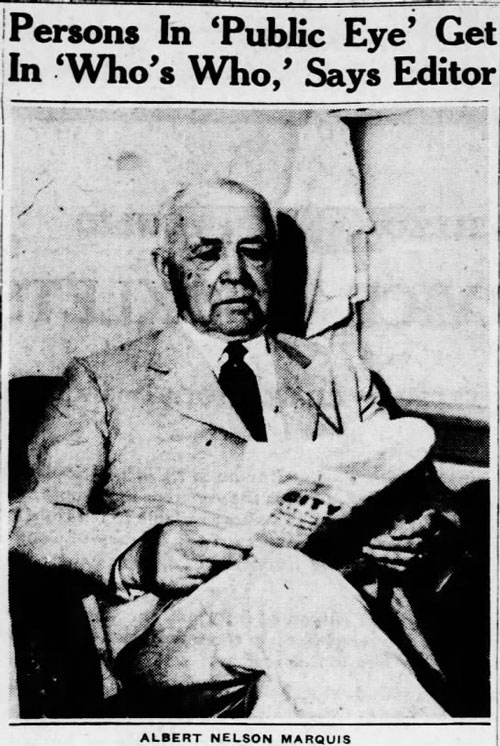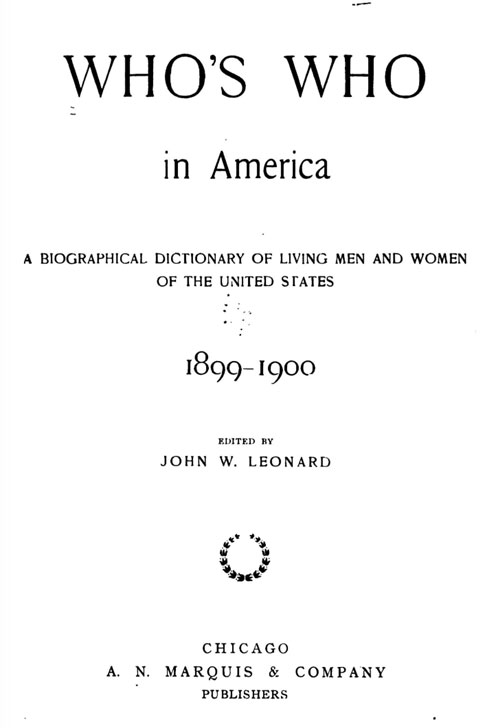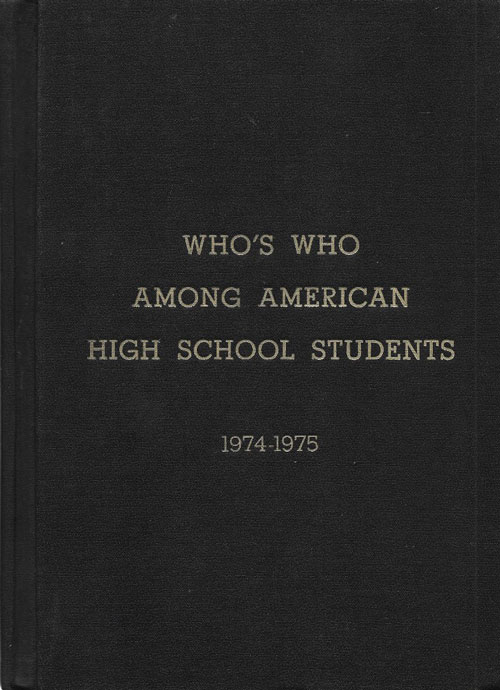Who’s Who? Who Cares
How the “Who’s Who” concept of reference books devolved from a genuinely useful idea into a very costly form of vanity publishing.
Sponsored By … You?
If you find weird or unusual topics like this super-fascinating, the best way to tell us is to give us a nod on Ko-Fi. It helps ensure that we can keep this machine moving, support outside writers, and bring on the tools to support our writing. (Also it’s heartening when someone chips in.)
1849
The year that the first edition of the British Who’s Who was published. The book, unlike many of its later competitors, has never accepted payment in exchange for getting noticed in the book, nor does it require recipients of the honor to buy the book. The book, published annually to this day, does feature entries written by the subjects, however, something handled through a questionnaire format.

Albert Nelson Marquis, shown in 1935. (The Arizona Republic)
The guy who brought “Who’s Who” to America had very high standards
“A study of biographic sketches is like a compass pointing the way to success. They all seem to revolve around formulas of environment, education, and opportunity that evolve careers.”
In 1925, the biographer became the subject of biography, however brief. Albert Nelson Marquis, a self-made publisher who started his own company and created a reference book focused on telling the stories of important people, was considered important enough that syndicated columnist Joe Mitchell Chapple wanted some time with him. At the time of the April 1925 interview, Marquis’ story arc was worthy of a good biography.
Orphaned as a young child, Marquis grew up in the stead of his maternal grandparents—who ensured he received both a proper education and job experience in the family’s general store. Marquis soon moved into publishing, launching his own publishing firm in the 1870s at the age of 21. The company started in Cincinnati, but eventually moved to Chicago, where Marquis formulated his grand idea—a reference book full of people who did notable enough things to get in the book.

The inside cover of the first edition of Who's Who in America. (Internet Archive)
The first edition of that book, while crediting its British equivalent for helping to inspire the idea, drew a line in the sand over what the book would actually cover.
“Without claiming infallibility or inerrancy, it is believed that this publication will be a welcome addition to the list of handy helps that make up the library of indispensable books,” the prologue for the 1899 document states. “Certainly nothing has been omitted that painstaking care, persistent effort, or expenditure of money could supply toward making the volume fully fill the purposes of its compilation.“
The book’s list of notables, already topping 8,000 in the first edition, included eery member of Congress along with nearly every other politician during the era. But, as the Chicago Tribune reported in 1986, Marquis was noted for his high standards of who actually got into the biennial book. Traditional celebrities from areas of culture such as film or sport were looked over in favor of educators, clergymen, or other notables that reflected Marquis’ own personal interests. He also tended to make moral judgments on the people he let in—with Frank Lloyd Wright’s personal life, including multiple marriages, leading to his longtime exclusion from the book.
But the book was notoriously inconsistent—for example, it wouldn’t take known criminals, but kept Richard Nixon in the book, a man who many considered a crook despite his protestations otherwise.
That inconsistency, over time, came to define the term “Who’s Who.”
“There's something like 286 books beginning with the title, ‘Who's Who in …’ Being in a ‘Who's Who’ is only slightly more prestigious than being in the telephone directory.”
— Derek Evans, the co-creator of Who's Nobody in America, a late-1970s attempt to take on the ubiquity of the “Who’s Who” format and its apparent tendency to limit who got into the document. Evans and his co-conspirator, Dave Fulwiler, took on the concept by suggesting they’d put anyone that wanted to be in the book to it, if they wanted to be there. Who’s Nobody, which actually went to print in 1981, was one of the earliest tongue-in-cheek attempts to take on a format that was starting to outgrow its relevance.

Who's Who Among American High School Students, which was not published by the same folks as Who's Who in America. (via Amazon)
The internet killed the relevance of “Who’s Who,” but the concept was already on the decline anyway
Did Donald Ray Grubbs deserve a spot in Who’s Who in America in the 1990s?
That’s a good question: Perhaps he didn’t, but he sure appreciated the notice. An employee of a firm that analyzed the structural integrity of industrial sites, he was cited in a 1999 Forbes article as someone who had shown up in a wide variety of “Who’s Who” publications over the years, and likewise purchased many of those items.
“I have nothing but praise to say about them because I think they’re [doing] a good job,” the Texas man stated with excitement. “People like me who really don’t get out there in the limelight, this is one of our ways of getting a little bit of recognition. And it feels good.”
The article, written by current Fox News megastar Tucker Carlson at a time when his collar was being held up with a bowtie on CNN, examined the recent history of the publication, and noted that despite Grubbs’ modest notability, his appearance in the book was the least of the problems with “Who’s Who.”
The main thing was that the publication moved from a watermark of notability to a way to self-submit autobiographies—which were rarely, if ever fact-checked.
A 1987 saga involving a writer with a sense of humor solidified the declining reputation of “Who's Who.” Joe Queenan, a humorist and onetime publication editor for the Ralph Ginzburg-owned American Business, tested this theory by taking a made up person in the magazine’s masthead, a guy named R.C. Webster, and submitting him to Who’s Who in America. As it turns out, Webster got in—and Queenan suddenly had an essay topic for The New Republic. A telling sample:
Did anyone from “Who’s Who” ever contact Mr. Webster to check for authenticity? Yes, once he got a letter asking what year he’d gotten his master’s degree. At this point, I changed F&M T&A to Houston Polytechnical Institute, to see if anyone was paying attention. Nobody was.
Queenan recommended that anyone who gets an invitation to submit a biography to “Who’s Who” should “embellish the hell out of it.”
The weakening standards of the Who’s Who in America series did not help the standing of the “Who’s Who” genre as a whole. But it may have been the least of its problems, to be honest.
Over time, the genre had become associated with scams and get-rick-quick schemes, a significant downgrade for what was once a highly respected medium.
It also didn’t help that there wasn’t really a trademark on the name due to its age, meaning that anyone who wanted to could launch a competing “Who’s Who” publication.
Certainly, this led to some tomes with a certain level of value. In 1967, publisher Paul Krouse, looking to combat the “hippie” image around high schoolers at the time, launched Who's Who Among American High School Students.
"Our perspective was there are still thousands upon thousands of students who are goal oriented who are doing good things and we simply wanted to create a vehicle, national in scope, that said to those students, ‘We see you,’” Krouse told The Morning Call in 1988. “It was simply meant to be and still continues to be the major purpose—to recognize the positive achievements of students."
But the issues that lingered around the more historic U.S. book followed its high school cousin, with many students seeing through the publication’s profit-driven facade. (The firm shut down in 2007.)
And things only got worse from there, with “Who’s Who” gaining an eventual association with spammy offerings not unlike the Nigerian scam emails of the late 2000s. Ben Rothke of the magazine CSO made the point as he dove into different services.
“Most of the who's who organizations are in it for the money with zero concern for to so-called honorees,” Rothke wrote.
Is a service like “Who’s Who” valuable or predatory? I guess the way that I would think about this is that folks want recognition. We want to be noticed. There is a sizable segment of the population that doesn’t feel that way.
That’s what makes this system work so well as a scam. The concept plays on our desire to be noticed in the basest, most damaging way possible.
We don’t need to show up in a vanity book to do that anymore! All we have to do is have a loud, annoying, divisive opinion somewhere, whether on our blogs, on Twitter, or in our Facebook bubbles.
But still, for quite obvious reasons, plenty of folks are still trying to make “Who’s Who” a thing.
Even the legitimate folks offering this service have probably taken things too far. Nearly 120 years after Albert Nelson Marquis stumbled upon the idea that made him famous, the company that bears his name is selling books featuring random people for hundreds of dollars despite there literally being about 500 million other ways to prove you’re notable in 2017.
Want someone to notice you? Start a podcast. It’s cheaper.

Please, if you're thinking of spending money on a .WhosWho domain, buy literally anything else.
Perhaps the thing that I saw that gave me the most pause involved something extremely modern. When I was wandering around the internet, trying to grasp the modern form of Who’s Who, I stumbled upon something that made me really depressed: Someone is selling a .WhosWho top-level domain to suckers willing to pay a lot of money for the privilege.
According to 101Domain, it would cost me $4,125 to buy ernie.whoswho.
“Words have meanings, and .WhosWho not only conveys the message that you’re no Yahoo, but also very much the opposite,” the registrar states.
I would disagree.
:format(jpeg)/2017/07/tedium071817.gif)
/2017/07/tedium071817.gif)


/uploads/ernie_crop.jpg)